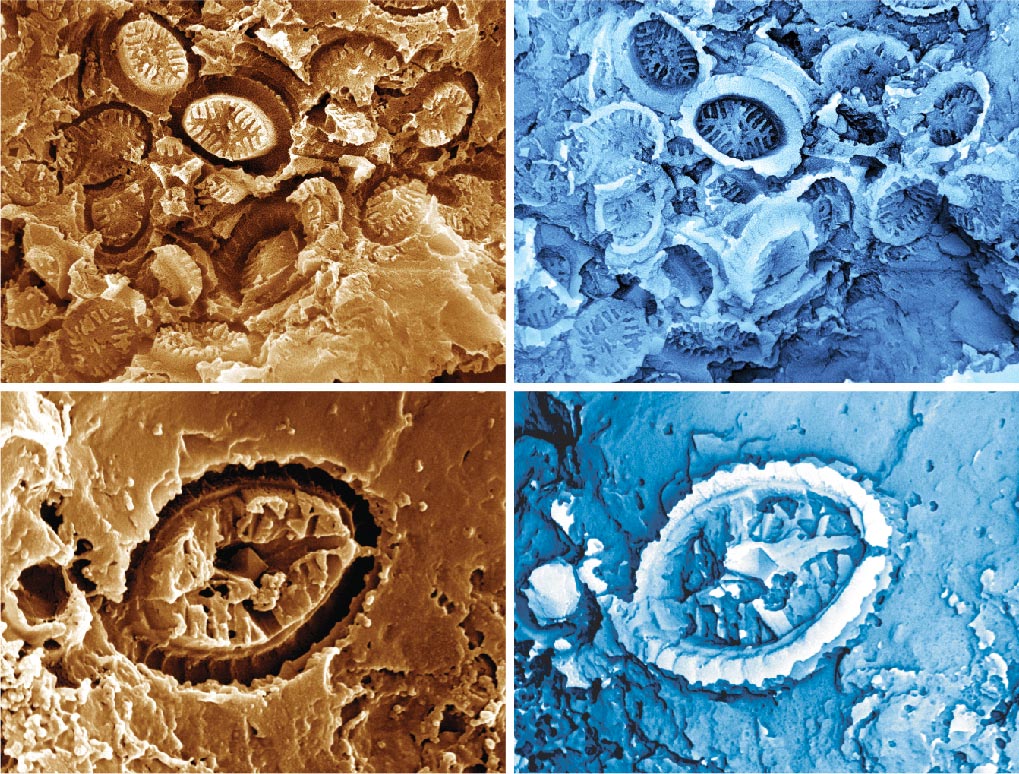Afbeeldingen tonen impressies van een ingestorte celwandbedekking (cocosfeer) op het oppervlak van een fragment van oud organisch materiaal (links) met individuele platen vergroot (siroop) om het opmerkelijke behoud van submicron-geschaalde structuren te laten zien (rechts). Het blauwe beeld wordt omgekeerd om een virtueel fossielbeeld te geven, dat wil zeggen om de originele 3D-vorm weer te geven. De originele platen werden door oplossing uit het sediment verwijderd, waarbij alleen sporen van geesten achterbleven. Credit: SM Slater, P. Bowen/Science Journal
Een internationaal team van onderzoekers heeft een nieuw type fossilisatie ontdekt.
De ontdekking van ‘spookfossielen’ onthult de veerkracht van plankton in het licht van de opwarming van de aarde in het verleden.
Een internationaal team van wetenschappers van University College London (UCL), het Swedish Museum of Natural History, het Natural History Museum (Londen) en de University of Florence heeft een opmerkelijke vorm van fossilisatie gevonden die tot nu toe vrijwel onopgemerkt is gebleven.
Fossielen zijn microscopisch kleine vingerafdrukken, of “geesten”, van eencellig plankton, coccolithoforen genaamd, dat miljoenen jaren geleden in zeeën leefde, en hun ontdekking zorgde voor een revolutie in ons begrip van hoe klimaatverandering plankton in de oceanen beïnvloedt.
Coccolithoforen zijn belangrijk in de oceanen van vandaag, ze leveren veel van de zuurstof die we inademen, ondersteunen mariene voedselwebben en vangen koolstof op in zeebodemsedimenten. Ze zijn een soort microscopisch plankton dat hun cellen omringt met harde kalksteenplaten, coccolieten genaamd, die gewoonlijk in rotsen ontbinden.
Afnames in de overvloed aan deze fossielen zijn gedocumenteerd uit verschillende pre-globale opwarmingsgebeurtenissen, wat aangeeft dat dit plankton ernstig is aangetast door klimaatverandering en verzuring van de oceaan. Er is echter vandaag een studie gepubliceerd in het tijdschrift Wetenschap Presenteert nieuwe wereldrecords voor de overvloedige spookfossielen van drie[{” attribute=””>Jurassic and Cretaceous warming events (94, 120, and 183 million years ago), suggesting that coccolithophores were more resilient to past climate change than was previously thought.

The individual plates are coccoliths. Credit: Images from Nannotax https://www.mikrotax.org/Nannotax3/
“The discovery of these beautiful ghost fossils was completely unexpected,” says Dr. Sam Slater from the Swedish Museum of Natural History. “We initially found them preserved on the surfaces of fossilized pollen, and it quickly became apparent that they were abundant during intervals where normal coccolithophore fossils were rare or absent – this was a total surprise!”
Despite their microscopic size, coccolithophores can be hugely abundant in the present ocean, being visible from space as cloud-like blooms. After death, their calcareous exoskeletons sink to the seafloor, accumulating in vast numbers, and forming rocks such as chalk.

The fossils are approximately 5 µm in length, 15 times narrower than the width of a human hair. Credit: S.M. Slater, P. Bown et al. / Science journal
“The preservation of these ghost nannofossils is truly remarkable,” says Professor Paul Bown (UCL). “The ghost fossils are extremely small ‒ their length is approximately five-thousandths of a millimeter, 15 times narrower than the width of a human hair! ‒ but the detail of the original plates is still perfectly visible, pressed into the surfaces of ancient organic matter, even though the plates themselves have dissolved away.”
The ghost fossils formed while the sediments at the seafloor were being buried and turned into rock. As more mud was gradually deposited on top, the resulting pressure squashed the coccolith plates and other organic remains together, and the hard coccoliths were pressed into the surfaces of pollen, spores, and other soft organic matter. Later, acidic waters within spaces in the rock dissolved away the coccoliths, leaving behind just their impressions – the ghosts.

Ghost nannofossils were found in rocks from global warming intervals where normal coccolithophore fossils were rare or absent. Credit: S.M. Slater, P. Bown, et al. / Science journal
“Normally, paleontologists only search for the fossil coccoliths themselves, and if they don’t find any then they often assume that these ancient plankton communities collapsed,” explains Professor Vivi Vajda (Swedish Museum of Natural History). “These ghost fossils show us that sometimes the fossil record plays tricks on us and there are other ways that these calcareous nannoplankton may be preserved, which need to be taken into account when trying to understand responses to past climate change.”
Professor Silvia Danise (University of Florence) says: “Ghost nannofossils are likely common in the fossil record, but they have been overlooked due to their tiny size and cryptic mode of preservation. We think that this peculiar type of fossilization will be useful in the future, particularly when studying geological intervals where the original coccoliths are missing from the fossil record.”

Ghost nannofossils were found globally, in rocks from three rapid warming events in Earth’s history (the T-OAE, OAE1a, and OAE2). Credit: S.M. Slater et al.
The study focused on the Toarcian Oceanic Anoxic Event (T-OAE), an interval of rapid global warming in the Early Jurassic (183 million years ago), caused by an increase in CO2-levels in the atmosphere from massive volcanism in the Southern Hemisphere. The researchers found ghost nannofossils associated with the T-OAE from the UK, Germany, Japan, and New Zealand, but also from two similar global warming events in the Cretaceous: Oceanic Anoxic Event 1a (120 million years ago) from Sweden, and Oceanic Anoxic Event 2 (94 million years ago) from Italy.
“The ghost fossils show that nannoplankton were abundant, diverse, and thriving during past warming events in the Jurassic and Cretaceous, where previous records have assumed that plankton collapsed due to ocean acidification,” explains Professor Richard Twitchett (Natural History Museum, London). “These fossils are rewriting our understanding of how the calcareous nannoplankton respond to warming events.”
Finally, Dr. Sam Slater explains: “Our study shows that algal plankton were abundant during these past warming events and contributed to the expansion of marine dead zones, where seafloor oxygen-levels were too low for most species to survive. These conditions, with plankton blooms and dead zones, may become more widespread across our globally warming oceans.”
Reference: “Global record of “ghost” nannofossils reveals plankton resilience to high CO2 and warming” by Sam M. Slater, Paul Bown, Richard J. Twitchett, Silvia Danise and Vivi Vajda, 19 May 2022, Science.
DOI: 10.1126/science.abm7330

“Bierliefhebber. Toegewijde popcultuurgeleerde. Koffieninja. Boze zombiefan. Organisator.”








More Stories
Een nieuw rapport zegt dat het gebruik van ras en etniciteit soms “schadelijk” is in medisch onderzoek
SpaceX lanceert 23 Starlink-satellieten vanuit Florida (video en foto’s)
NASA zegt dat de “Halloween-komeet” zijn vlucht langs de zon niet heeft overleefd